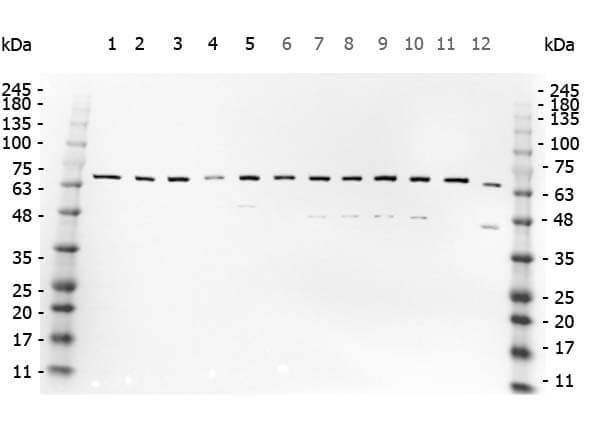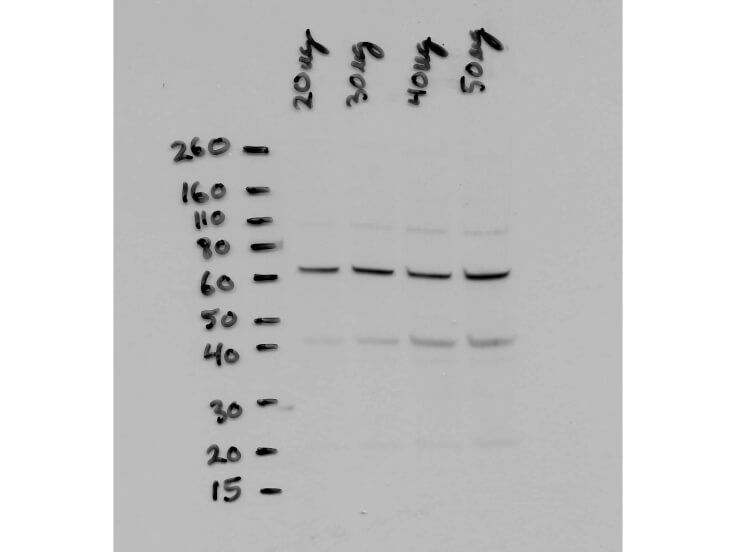Datasheet is currently unavailable. Try again or CONTACT US
NFkB p65 Antibody
Rabbit Polyclonal
34 References
100-4165S
100-4165
25 µL
100 µL
Liquid (sterile filtered)
Liquid (sterile filtered)
WB, ELISA, IHC, IF, ChIP, EMSA, IP
Human, Mouse
Rabbit
Shipping info:
$50.00 to US & $70.00 to Canada for most products. Final costs are calculated at checkout.
Product Details
Anti-NFKB p65 (Rel A) (RABBIT) Antibody - 100-4165
rabbit Anti-NFKB p65 antibody, rabbit Anti-Rel A antibody, NFKB, nfkb, NF-kB, NF-kappaB, NFkappaB, Nuclear factor NF-kappa-B p65 subunit
Rabbit
Polyclonal
Antiserum
Target Details
RELA - View All RELA Products
Human, Mouse
Conjugated Peptide
NFkB p65 (Rel A) peptide corresponding to a region near the C-terminus of the human protein conjugated to Keyhole Limpet Hemocyanin (KLH).
NFkB p65 (Rel A) was prepared from monospecific antiserum by delipidation and defibrination. Anti-NFkB p65 (Rel A) may react non-specifically with other proteins. Control peptide (code #100-4165p) will compete only with the specific reaction of antiserum with the NFkB p65 (Rel A) subunit.
Application Details
ELISA, IHC, WB
ChIP, EMSA, IF, IP
- View References
Anti-NFkB p65 (Rel A) is tested by immunoblot of human and mouse NFkB p65 (Rel A), immunohistochemistry, and ELISA. This product was also tested in a gel supershift assay, IP, IF, and ChIP and found to be reactive against all p65 (Rel A) containing human, mouse or rat NFkB complexes using 0.5 to 1.0 µl per assay.
Formulation
80 mg/mL by Refractometry
None
0.01% (w/v) Sodium Azide
None
Shipping & Handling
Dry Ice
Store NF-kappaB antibody at -20° C prior to opening. Aliquot contents and freeze at -20° C or below for extended storage. Avoid cycles of freezing and thawing. Centrifuge product if not completely clear after standing at room temperature. This product is stable for several weeks at 4° C as an undiluted liquid. Dilute only prior to immediate use.
Expiration date is one (1) year from date of receipt.
Anti-NFkB p65 Antibody recognizes NFKB p65 which is a component of NFKB. NFKB was originally identified as a factor that binds to the immunoglobulin kappa light chain enhancer in B cells. It was subsequently found in non-B cells in an inactive cytoplasmic form consisting of NFkappaB bound to IkappaB. NFkappaB was originally identified as a heterodimeric DNA binding protein complex consisting of p65 (RelA) and p50 (NFKB1) subunits. Other identified subunits include p52 (NFKB2), c-Rel, and RelB. The p65, cRel, and RelB subunits are responsible for transactivation. The p50 and p52 subunits possess DNA binding activity but limited ability to transactivate. p52 has been reported to form transcriptionally active heterodimers with the NFkappaB subunit p65, similar to p50/p65 heterodimers. The heterodimers of p52/p65 and p50/p65 are regulated by physical inactivation in the cytoplasm by IkappaBalpha. IkappaBalpha-binds to the p65 subunit, preventing nuclear localization and DNA binding. Low levels of p52 and p50 homodimers can also exist in cells.
Gao T et al. (2022). Ameliorating Inflammation in Insulin-resistant Rat Adipose Tissue with Abdominal Massage Regulates SIRT1/NF-κB Signaling. Cell Biochem Biophys.
Applications
WB, IB, PCA
Follis RM et al. (2021). Metabolic control of sensory neuron survival by the p75 neurotrophin receptor in Schwann cells. J Neurosci.
Applications
IF, Confocal Microscopy
Cleary et al. (2017). NFκB signaling in alveolar rhabdomyosarcoma. Disease Models & Mechanisms
Applications
Supershift, Gel Shift, EMSA
Passos E et al. (2015). Role of physical exercise on hepatic insulin, glucocorticoid and inflammatory signaling pathways in an animal model of non-alcoholic steatohepatitis. Life Sci
Applications
WB, IB, PCA
Ryu, S et al. (2015). Suppression of Propionibacterium acnes Infection and the Associated Inflammatory Response by the Antimicrobial Peptide P5 in Mice. PloS One
Applications
IF, Confocal Microscopy
Fang IM et al. (2014). Chitosan oligosaccharides attenuate ocular inflammation in rats with experimental autoimmune anterior uveitis. Mediators Inflamm.
Applications
IHC, ICC, Histology; WB, IB, PCA
Brune M et al. (2013). Depletion of the receptor for advanced glycation end products (RAGE) sensitizes towards apoptosis via p53 and p73 posttranslational regulation. Oncogene
Applications
WB, IB, PCA
Hariri F et al. (2013). The eukaryotic translation initiation factor eIF4E is a direct transcriptional target of NF-κB and is aberrantly regulated in acute myeloid leukemia. Leukimia
Applications
Supershift, Gel Shift, EMSA
Albaghdadi AJH et al. (2012). Endometrial receptivity defects and impaired implantation in diabetic NOD mice. Biol Reprod
Applications
WB, IB, PCA
Inaba-Hasegagawa K et al. (2012). Rasagiline and selegiline, inhibitors of type B monoamine oxidase, induce type A monoamine oxidase in human SH-SY5Y cells. J Neural Tranm (Viena).
Applications
Undefined
Djuric Z et al. (2012). Targeting activation of specific NF-κB subunits prevents stress-dependent atherothrombotic gene expression. Mol Med.
Applications
ChIP; WB, IB, PCA
Herkenham M et al. (2011). Cautionary notes on the use of NF-κB p65 and p50 antibodies for CNS studies. J Neuroinflammation.
Applications
WB, IB, PCA
Gonzalez-Velasquez F, Reed JW, Fuseler JW, et al. (2011). Activation of brain endothelium by soluble aggregates of the amyloid-β protein involves nuclear factor-κB. Curr Alzheimer Res.
Applications
IHC, ICC, Histology
Limpert et al. (2010). Axonal Neuregulin 1 Type III Activates NF-kappa B in Schwann Cells during Myelin Formation. J Bio Chem.
Applications
IP, Co-IP; WB, IB, PCA; Supershift, Gel Shift, EMSA
Begley et al. (2008). CXCL5 promotes prostate cancer progression. Neoplasia
Applications
WB, IB, PCA
Yoon et al. (2008). Protein kinase A-induced phosphorylation of the p65 subunit of nuclear factor-kappaB promotes Schwann cell differentiation into a myelinating phenotype. J. Neuro.
Applications
WB, IB, PCA; IP, Co-IP; Supershift, Gel Shift, EMSA
Lou et al. (2007). Glutathione depletion down-regulates tumor necrosis factor alpha-induced NF-kappaB activity via IkappaB kinase-dependent and -independent mechanisms. J Bio Chem.
Applications
Supershift, Gel Shift, EMSA; WB, IB, PCA; ChIP
Cao et al. (2006). NF-kappaB1 (p50) homodimers differentially regulate pro- and anti-inflammatory cytokines in macrophages. J Bio Chem.
Applications
Supershift, Gel Shift, EMSA
Begley et al. (2005). CXCL12 overexpression and secretion by aging fibroblasts enhance human prostate epithelial proliferation in vitro. Aging Cell.
Applications
WB, IB, PCA
Maruyama W et al. (2004). N-Propargyl-1 (R)-aminoindan, rasagiline, increases glial cell line-derived neurotrophic factor (GDNF) in neuroblastoma SH-SY5Y cells through activation of NF-κB … Neurochemistry
Applications
EIA, ELISA; WB, IB, PCA
Feng B et al. (2004). NF-κB inducible genes BCL-X and cyclin E promote immature B-cell proliferation and survival. Cell Immunol
Applications
Supershift, Gel Shift, EMSA
Chapman et al. (2004). Expression and deoxyribonucleic acid-binding activity of the nuclear factor kappaB family in the human myometrium during pregnancy and labor. J Clin Endocrinol Metab.
Applications
WB, IB, PCA
Gregory et al. (2004). Efficient replication by herpes simplex virus type 1 involves activation of the IkappaB kinase-IkappaB-p65 pathway. J Virol.
Applications
WB, IB, PCA
Fan et al. (2004). Divergent C-terminal transactivation domains of Rel/NF-kappa B proteins are critical determinants of their oncogenic potential in lymphocytes. Oncogene
Applications
IP, Co-IP
Poser et al. (2003). Upregulation of HMG1 Leads to Melanoma Inhibitory Activity Expression in Malignant Melanoma Cells and Contributes to Their Malignancy Phenotype. Mol Cell Biol.
Applications
IP, Co-IP
Cheng et al. (2003). Cyclin E and Bcl-xL cooperatively induce cell cycle progression in c-Rel-/- B cells. Oncogene
Applications
WB, IB, PCA
Haller D et al. (2003). Transforming growth factor-beta 1 inhibits non-pathogenic Gram negative bacteria-induced NF-kappa B recruitment to the interleukin-6 gene promoter in intestinal epithelial cells through modulation of histone acetylation. J Biol Chem.
Applications
IP, Co-IP
Frost LL et al. (2001). Propanil inhibits tumor necrosis factor-α production by reducing nuclear levels of the transcription factor nuclear factor-κB in the macrophage cell line IC-21. Toxicol Appl Pharmacol.
Applications
Supershift, Gel Shift, EMSA
Holmes-McNary MQ et al. (2001). Opposing regulation of choline deficiency-induced apoptosis by p53 and nuclear factor κB. J Biol Chem
Applications
Supershift, Gel Shift, EMSA
Jobin et al. (1999). Curcumin blocks cytokine-mediated NF-kappa B activation and proinflammatory gene expression by inhibiting inhibitory factor I-kappa B kinase activity. J Immunol.
Applications
IF, Confocal Microscopy; Supershift, Gel Shift, EMSA
Tsubota K et al. (1999). Regulation of human leukocyte antigen expression in human conjunctival epithelium. Invest Opthalmol Vis Sci.
Applications
IF, Confocal Microscopy
Miller WE et al. (1998). The NPC derived C15 LMP1 protein confers enhanced activation of NF-κB and induction of the EGFR in epithelial cells. Oncogene
Applications
Supershift, Gel Shift, EMSA
Miller WE et al. (1998). Interaction of tumor necrosis factor receptor-associated factor signaling proteins with the latent membrane protein 1 PXQXT motif is essential for induction of epidermal growth factor receptor expression Mol Cell Biol
Applications
Supershift, Gel Shift, EMSA
Cheshire JL et al. (1997). Synergistic activation of NF-kappaB by tumor necrosis factor alpha and gamma interferon via enhanced I kappaB alpha degradation and de novo I kappaBbeta. Mol Cell Biol
Applications
Supershift, Gel Shift, EMSA
This product is for research use only and is not intended for therapeutic or diagnostic applications. Please contact a technical service representative for more information. All products of animal origin manufactured by Rockland Immunochemicals are derived from starting materials of North American origin. Collection was performed in United States Department of Agriculture (USDA) inspected facilities and all materials have been inspected and certified to be free of disease and suitable for exportation. All properties listed are typical characteristics and are not specifications. All suggestions and data are offered in good faith but without guarantee as conditions and methods of use of our products are beyond our control. All claims must be made within 30 days following the date of delivery. The prospective user must determine the suitability of our materials before adopting them on a commercial scale. Suggested uses of our products are not recommendations to use our products in violation of any patent or as a license under any patent of Rockland Immunochemicals, Inc. If you require a commercial license to use this material and do not have one, then return this material, unopened to: Rockland Inc., P.O. BOX 5199, Limerick, Pennsylvania, USA.

_antibody_1_IHC_4x3.jpg)




